1. Meaning:
learning, science, study
2. Readings:
3. Etymology
学 belongs to the 会意文字 (かいいもじ, kaii moji, i.e. set of characters that are a combination of two or more pictographs, or characters whose meaning was based on an abstract concept).
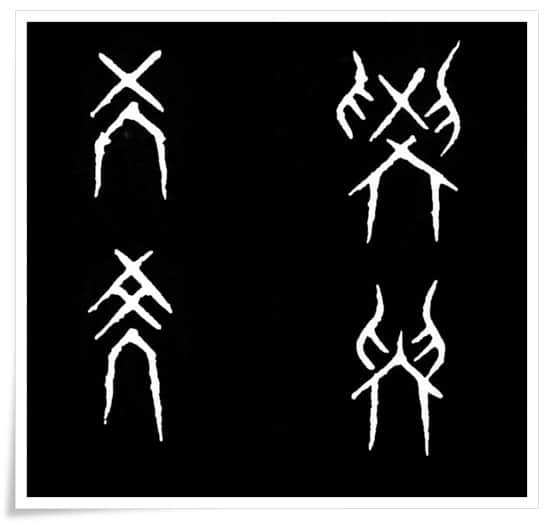
The traditional form of this character is 學 (Figure 5). It is formed from 4 individual elements: 爻 (こう, kō, i.e. “join”, “mix”), 臼 (きゅう, kyū, i.e “mortar”), or more precisely 𦥑 (きょく, kyoku, i.e. “to operate with two hands”; 臼 incorporates the meaning of 𦥑, as one operates a grinding rod on a mortar with both hands), 冖 (べき, beki, i.e. “roof radical”), 子 (こ, ko, i.e. “a child”). The oldest form of 学, as shown in Figure 1, is a pictograph of a building facade, with ornamental crossed rafter ends, often found today on traditional Japanese buildings or shrines. It is possible that 学 originally was a reference to a male (only) building. In later stages, a pictograph of two hands was added (𦥑), and a pictograph of a child (子). However, occasionally, we find forms of 學 that combine only 爻 and 子 elements (compare characters in Figure 1).
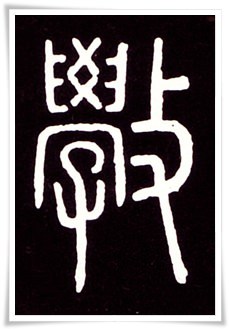
According to the 說文解字 (shūo wén jiě zì, i.e. “Explaining Simple (Characters) and Analyzing Compound Characters”) from the 2nd century C.E., compiled by a philologist of the Han dynasty (漢朝, 206 BCE – 220 CE), 許慎 (Xǔ Shèn, ca. 58 C.E. – ca. 147 C.E.), the character 學 had yet another even more complex form, (斅; in Figure 2), used in decorative writing (found already in 金文 (きんぶん, kinbun, i.e. “text on metal”), appearing as early as from c.a. 1200 B.C. The “simplified” 學 was the same character (etymologically) with reduced number of strokes. Chronologically, 斅 appeared later than the simpler forms.. It would mean that this kanji’s structure (and its stroke count) was in fact made more complex on purpose.
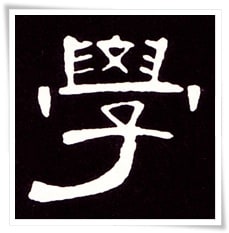
There is, however, a slight semantic difference between 斅 and 學. In 說文解字 we read that the meaning of 斅 was narrowed down to “enlightenment”. According to the Chinese dictionary 玉篇 (Chinese: Yùpiān ) from 543 C.E., that lists over 12,000 characters, 斅 stood for “gaining knowledge by teaching oneself”, whereas 學 for “receiving knowledge (from another person)”.
It is curious that 敎, which is an older form of 教 (きょう, kyō, i.e. “teach”, “doctrine”), follows the character 學 quite closely (etymologically speaking). As you can see the left-hand side compounds of 敎 clearly match core elements of 學. The right hand side radical of 敎 (攵, ほく, hoku, i.e. “to strike / hit”, also a folding chair radical) was once written as 攴 (ほく, hoku, “to strike / hit”, also a folding chair radical). By adding 攴, the meaning of 敎 was defined as “teaching another person”. It is possible that 攴 was to emphasise the authoritative position of a teacher (hit/strike = discipline).
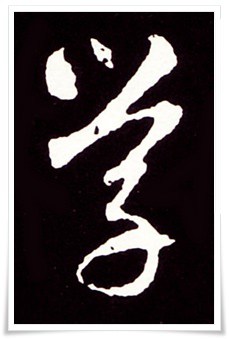
Today’s form of 学 was derived from the cursive script (行書, ぎょうしょ, gyōsho) from of 學. Please refer to Figure 4.
4. Selected historical forms of 学.
Figure 1. Four variants of the oracle bone script (甲骨文, こうこつぶん, kōkotsubun) forms of 学, from ca.1600 – 1300 B.C.
Figure 2. Small Seal script (小篆, しょうてん, shōten)form of the character 学 (斅), found in the book 說文解字 (shūo wén jiě zì, i.e. “Explaining Simple (Characters) and Analyzing Compound Characters”) from the 2nd century C.E., compiled by a philologist of the Han dynasty (漢朝, 206 BCE – 220 CE), 許慎 (Xǔ Shèn, ca. 58 C.E. – ca. 147 C.E.).
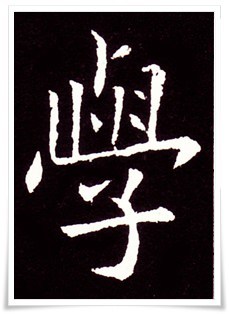
Figure 3. In rubbing of the clerical script (隷書, れいしょ, reisho) form, or more precisely, 八分隷 (はっぷんれい, happun rei, i.e. “mature clerical script), whose concept is based on the symmetrical slanting strokes of the character 八 (はち, hachi, i.e. eight”), of the character 学 (學), found on the stele 曹全碑 (Chinese: Cáo quán bēi), Han dynasty (漢朝, 206 B.C. – 220 C.E.), 185 C.E.
Figure 4. Ink rubbing of the character 学 (學) in cursive script (草書, そうしょ, sōsho) from the calligraphy 千字文寶墨軒 (Chinese: Qiān zì wén bǎo Mó xuān) by 智永 (Zhì Yǒng, unfortunately his exact dates of birth and death are unknown) of the Chen dynasty (陳朝, 557 – 589 C.E.).
Figure 5. Ink rubbing of one of the variations of the standard script (楷書, かいしょ, kaisho) forms of the character 学 (學), taken of the Jiucheng palace stele (九成宫碑, Chinese: Jiǔ chéng gōng bēi), Tang dynasty (唐朝, 618 – 907).
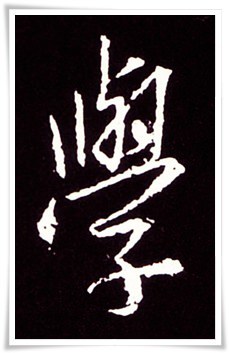
Figure 6. Semi-cursive script (行書, ぎょうしょ, gyōsho) of the character 学 (學). Ink rubbing from the calligraphy work compilation entitled 集王聖教序 (Chinese: Jí Wáng shèng jiào xù), created on the order of the Emperor 唐太宗 (Chinese: Táng Tài zōng), of the Tang dynasty (唐朝, 618 – 907).
